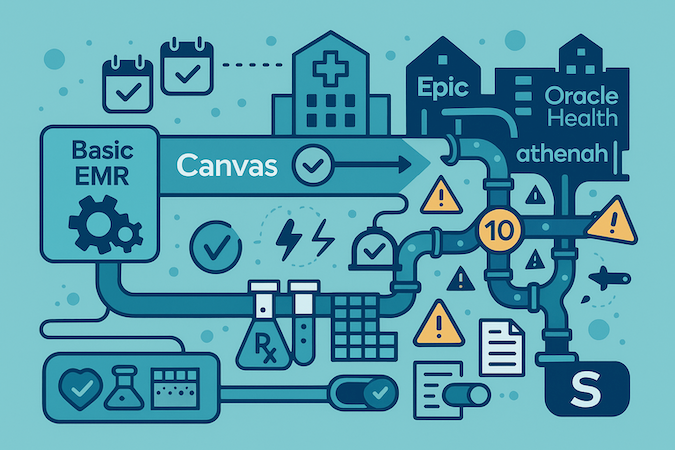Everything You Need to Know Before Using Base44 for Your Health App
If your first users are clinicians, your MVP is production—treat it that way. We compare Base44 and Specode for health apps, map the fast path, and show how to avoid the month-8 rebuild.
TLDR: Base44 is for proving the idea; Specode is for shipping healthcare software without duct-taping compliance later.
Key Takeaways
- Use Base44 for non-PHI prototypes; switch before real data. Great for validating flows fast; once you need audit trails, consent, and RBAC, the retrofit tax spikes. Migrate before PHI touches prod.
- Specode = reusable HIPAA components + code ownership. You start with clinical scaffolds (RBAC, audit, consent), add Care Delivery (telehealth, scheduling, comms), and keep full control of the repo. Canvas is the fast path; Epic/Oracle Health/eRx/labs are scoped integrations, not toggles.
- TCO flips after Month 2. The 12-month cost curve is Compliance + Integrations + Ops + Rework minus Reuse; Specode shifts spend from retrofitting to reusing, so you avoid the Month-8 rebuild.
Why Your Healthcare Prototype Just Failed Its First Audit
The demo killed. Your React app handles appointments smoothly, the UX feels clean, and your investor's nodding along—until they ask the question that changes everything: "Where's your BAA? How are you handling PHI? Can you show me the audit logs?"
Silence.
You just discovered the canyon between a working app and HIPAA-compliant healthcare app development. That slick Base44 prototype you shipped in two weeks? It becomes a compliance nightmare the moment real patient data touches it.

Since 2023, U.S. healthcare firms have paid tens of millions of dollars in settlements and enforcement payments tied to tracking technologies. Not core functionality failures—just marketing pixels. Here are a few notable examples:
- Advocate Aurora Health: $12.25M for a Meta pixel.
- Novant Health — $6.6M.
- BetterHelp: $7.8M.
These weren't fly-by-night operations; they were established providers who thought they could figure out compliance later.
The broader picture gets uglier. HIPAA Journal’s 2024 report tallied 725 large healthcare data breaches and ~275 million records exposed—about 751,000 a day; even excluding the Change Healthcare mega-breach, ~85 million records were still exposed.
When breaches hit, they hit hard: industry reports peg average cost of $9.77 million in healthcare versus $4.88 million across other industries. Your prototype just became a ticking liability bomb.
"Failure to conduct a HIPAA Security Rule risk analysis leaves health care entities vulnerable to cyberattacks, such as ransomware. Knowing where your ePHI is held and the security measures in place to protect that information is essential for compliance with HIPAA."
Melanie Fontes Rainer, former OCR Director
The brutal math? Retrofitting compliance into an existing healthcare application development project typically costs 3-5x more than building it right from the start. Most teams discover it's actually cheaper to rebuild entirely with HIPAA-compliant patterns baked in.
Your Base44 prototype proved market fit. Great. But between that proof and production lies a gauntlet of authentication contexts, immutable audit trails, consent workflows, breach protocols, and integration requirements that generic platforms simply don't address.
Healthcare app development isn't just development with extra paperwork—it's a fundamentally different engineering discipline.
What Base44 Gets Right (and Why It's Not Enough)
Let's be honest: Base44 nails the prototyping game. Chat your way to a working app in hours. Database schemas auto-generate. Authentication just works. Payments integrate seamlessly. For validating ideas with non-sensitive data, it's genuinely impressive tech.

The numbers back this up. Maor Shlomo built Base44 to 250,000 users and profitability in six months, landing an $80M cash acquisition from Wix. Major enterprises like eToro and SimilarWeb signed partnership deals. That's not hype—that's market validation of the "vibe coding" movement where you describe what you want and AI builds it.
For general healthcare app development MVP testing—scheduling interfaces, patient feedback forms, marketing sites—Base44 delivers speed-to-market that traditional development can't touch. You can validate UX patterns, test conversion flows, and gather user feedback while your competitors are still writing requirements docs.
But healthcare production demands a fundamentally different architecture, and that's where generic platforms hit a wall.
What Breaks When Clinical Reality Shows Up
The breaking points emerge the moment clinical reality enters the picture:
Role-Based Access
Role-based access isn't just user permissions—it's legally mandated separation between patients, providers, supervisors, billing staff, and auditors. Each role needs distinct data views, time-boxed escalation privileges, and break-glass procedures for emergencies. Base44's simple auth model doesn't comprehend these healthcare-specific access patterns.
Immutable Audit Trails
Immutable audit trails aren't optional logging—they're forensic evidence for breach investigations and compliance audits. Every view, create, update, and export needs cryptographic timestamps, user attribution, and tamper-proof storage. Healthcare organizations need to prove not just what happened, but prove nothing else could have happened. Generic platforms treat logs as debugging tools, not legal documents.
Consent Management
Consent management goes beyond cookie banners. You're tracking treatment consent, data sharing agreements, research participation, state-specific privacy rules, and revocation workflows. When a patient withdraws consent for their mental health records to be shared with their PCP, your system needs to enforce that granular preference across every integration point.
The "just add HIPAA later" approach inevitably crashes into reality. Teams discover they need to rebuild authentication from scratch to support provider contexts. The database schema requires fundamental changes to support audit requirements. Every third-party integration needs rearchitecting for BAA compliance.
The technical debt compounds exponentially. That two-week prototype becomes a six-month rebuild, except now you're migrating live patient data, retraining staff, and explaining to investors why the "90% complete" app needs starting over. We've seen teams burn through entire funding rounds trying to retrofit compliance into platforms that were never designed for healthcare's requirements.
Who Should Use What?
- Choose Base44 now if you need a non-PHI prototype to validate flows with fake data and pitch.
- Choose Specode now if you will touch PHI within 90 days, need auditability on Day 1, or foresee EHR/eRx/Lab work in Year 1.
- Hybrid path: build proof on Base44, then follow your “Mini Migration” plan to Specode before PHI hits prod.
Base44 proves you can build fast. But in health app development, fast without compliant is just an expensive detour. The platforms that win understand this from day one.
Base44 HIPAA & BAA (for Healthcare Apps) — and a Base44 Alternative
If your use case touches PHI, you need two hard answers up front:
- Will the platform sign a BAA?
- What healthcare-grade guardrails exist on day one?
Based on Base44’s public materials as of Oct 31, 2025, there’s no explicit HIPAA/BAA support; in fact, their terms restrict submitting “sensitive data… such as protected health information” unless there’s a separate written agreement.
Healthcare-Critical Capabilities — Base44 vs Specode
Real Numbers: TCO and Timeline Comparison
Initial build is a feel-good number. In healthcare app development, the bill that hurts lives in months 3–12—compliance ops, integrations, rework, and the “platform tax” when you don’t own the code. Base44 shines in the 0–2 month window; after that, costs shift from shipping screens to running regulated software.
The 12-Month Reality
- Months 0–2 — Prototype velocity. Base44 is perfect for fast UX/CRUD and stakeholder demos.
- Months 3–6 — Gravity hits. HIPAA hardening, audit coverage, BAAs, and the first EHR/eRx/lab path stall schedules; QA balloons.
- Months 6–12 — Maintenance tax. Vendor version drift, re-tests, incident runbooks, and integration support become a standing line item.
The 12-Month Cost Stack
- Build (Months 0–2): prototype + initial scaffolding.
- Compliance (Months 3–12): risk analysis, audit trails, consent, incident prep—recurring, not one-off.
- Integrations: EHR/eRx/labs initial setup + periodic re-tests/cert cycles.
- Operations: monitoring, on-call, security updates, change windows.
- Rework: everything you redo because “HIPAA later” didn’t hold up.
- Minus Reuse: what you don’t pay again because you started on healthcare rails (e.g., Specode’s basic EMR + HIPAA-aware components).
Plain math: TCO (12 months) = Build + Compliance + Integrations + Ops + Rework − Reuse. The only lever that reliably lowers TCO without wishful thinking is Reuse.
Why Code Ownership Changes the Curve
“Platform tax” shows up when you can’t take your code with you, or you can’t modify the runtime to meet clinical realities (RBAC, audit, consent, PHI-safe data shapes). Specode emphasizes full code ownership and ships healthcare-aware scaffolding, so you stop paying to retrofit fundamentals and start reusing them across features.
A Quick Back-of-Napkin Test
- List the integrations you must support in Year 1 (Canvas now; others later). Mark which require BAAs/certification.
- For each, add a re-test line (quarterly updates, version drift, sandbox → prod cutovers).
- Subtract anything you can reuse if you start on Specode rails (identity/RBAC, audit emitters, consent hooks, PHI-safe data shapes).
- If “Rework” > “Reuse,” your cheapest option today becomes your most expensive by Q3.
Base44 gets you a demo fast. Specode keeps you out of the Month-8 rebuild by front-loading the parts you’ll need anyway—and letting you own the code that carries into production.
The HIPAA Infrastructure You Can’t Bolt On Later
You don’t “add HIPAA.” You design for it. In practice, production rails come down to four things you either build in early—or rebuild later at 3–5× the cost.

Authentication Built for Care Roles
Healthcare identity isn’t “user vs admin.” It’s clinicians, patients, billing, supervisors—often across orgs.
- Least-privilege role sets per persona; org/context preserved via SSO/SAML.
- Time-boxed elevation and break-glass with auto-notify + post-incident review.
- Device posture checks (managed, encrypted) before any ePHI access.
Forensic Audit and Breach Posture
Logs are legal evidence, not debug prints. Design them that way.
- Capture who/what/when/where/why for every PHI touch; retain immutably.
- Chain-of-custody and integrity (hashing/signing) for exports.
- Real-time signals for high-risk events (bulk export, after-hours VIP lookups).
- Segmented/zero-trust network so incidents are contained, not broadcast.
PHI-Safe Data Modeling
Privacy isn’t a middleware. It’s your schema and services.
- Segment by sensitivity (demographics vs clinical vs billing) with separate keys and policies.
- Encrypt by default (in transit + at rest; field-level for especially sensitive notes).
- Temporal versioning/soft deletes for traceability and point-in-time recovery.
- Key management with rotation and least-access services.
Consent as a First-Class System
Policies must be enforced across every integration and view.
- Model granular consent (treatment, research, sharing, marketing) with expirations.
- Revocation propagation—downstream APIs, reports, caches must update immediately.
- State-aware rules without code forks (policy engine > ad-hoc ifs).
If your prototype skipped these, you’re not “tightening screws”—you’re changing the chassis. Decide now: augment with healthcare rails or migrate to a stack that has them baked in.
Integration Reality Check: EHRs, eRx, Labs, and the APIs That Matter
The productive way to avoid “Phase-2 purgatory” is to ship with a clinical core that works on day one, then add enterprise pipes deliberately—not the other way around.

Start with a Working Clinical Core
Specode ships with a Basic EMR component—your starter clinical backbone—so you can model real workflows before touching messy vendor ecosystems. It gives product, design, and QA a stable surface to build against while you line up external connections.
Fast Path: Canvas Medical
Canvas is our developer-friendly baseline: modern REST/FHIR, webhooks, sensible docs. Specode integrates with Canvas cleanly, so pilots can move from demo data to real clinical flows without diving into legacy protocol archaeology.
- Use Canvas when you want quick, reliable data movement and eventing while staying focused on product value, not HL7 dialects.
Enterprise EHRs (Epic, Oracle Health/Cerner, athena): Reality, Not Theory
Integration isn’t “pure FHIR”; it’s their profiles, their validation, their cutover choreography. Each health system adds its own rules, tickets, and calendars.
- Expect certification/attestation steps, sandbox quirks, rate limits, and version drift that reopen testing every quarter.
- Budget for patient matching strategy, environment provisioning, and change-window constraints you can’t simply parallelize.
eRx and Labs: Regulated Workflows, Not Just Endpoints
eRx blends clinical workflow with federal/state rules (EPCS, PDMP, identity proofing, 2FA). Labs add LOINC variance, units/ranges, and critical-result escalation that must be auditable.
- Treat network certifications, per-transaction economics, and edge-case flows (partial fills, prior auth) as first-class scope.
- Build a normalization layer for lab results (code mapping, unit conversions, reference ranges) plus acknowledged critical-value routing.
Why “Later” Never Comes—and How We Frame It
Underestimation comes from calendar realities: legal reviews, provisioning, certification, version changes, and go-live windows. That’s why Specode’s approach is pragmatic:
- Ship now on the basic EMR to prove clinical value.
- Roadmap enterprise EHR, eRx, and lab integrations as dedicated implementation projects with the testing and ops guardrails you’ll live with in production.
Start with a usable clinical core, choose a friendly pipe (Canvas) when speed matters, and schedule the heavy integrations like the real projects they are. That’s how you avoid integration hell—and still ship.
How Specode Helps Healthcare Teams Ship Production Apps
If your Base44 prototype proved demand, don’t rebuild from scratch. Keep the UX truth and move onto rails designed for PHI, auditability, and integrations. Starting on Specode instead of prototyping elsewhere and migrating later typically gets teams to a HIPAA-aware prototype in weeks, not months.

What You Keep
- Validated flows & IA (screens, copy, micro-interactions)
- Your domain language (entities, statuses, queues)
- Content/brand and user-tested patterns that already work
What Specode Adds on Day One
Clinical Core
- Clinical documentation primitives (encounters, SOAP notes).
- Immutable audit hooks (event emitters ready for log pipelines).
Care Delivery (Telehealth, Scheduling, Comms)
- Secure video visits with waiting room and in-session chat.
- Chat (1:1 & group), file sharing, and notifications (in-app/email/SMS/push) with HIPAA-safe templates.
- Patient self-booking with live slots, provider calendars, buffers/visit types.
- Provider search with real-time availability.
- Unified authentication with MFA-ready hooks.
Experience (Dashboards, Profiles, Trackers)
- Patient dashboard: booking, trackers, resources/after-visit materials.
- Provider dashboard: today’s schedule and patient context.
- Patient & provider profiles.
- Symptom/mood/vitals tracking, goals & outcomes.
Monetization (Commerce)
- Catalog, cart, HIPAA-aligned checkout (eligibility/data capture).
- Payment wiring to your processor as needed.
Guardrails by Default
- HIPAA-aware scaffolding: roles/RBAC, consent capture, immutable audit emitters.
- AI builder assembles screens/data models with safe defaults.
- You own the code.
Integration Stance (Reality-First)
- Canvas Medical is the fast, modern pipe.
- Epic/Oracle Health, eRx, labs, biometrics: handled case-by-case via native APIs/middleware/partners—scoped projects, not toggles.
Mini Migration (Zero-Drama Version)
- Shadow Data: mirror Base44 entities into Specode; nightly reconcile.
- Identity & RBAC (Week 1): migrate users, wire SSO/MFA, surface consent points, turn on audit events.
- Core Flows (Weeks 2–3): port the 2–3 workflows that matter using healthcare components; keep the prototype live as control; instrument everything.
- Canvas Writes + Hardening (Week 4): flip from read-only to writes, smoke + load tests, feature-flagged rollback path.
Time You Save by Starting on Specode
- Skip the retrofit cycle (re-auth, re-audit, re-consent) that turns a quick demo into a month-8 rebuild.
- Avoid double QA and backfills caused by runtime switching.
- Reuse the same healthcare scaffolds as features expand (telehealth, scheduling, dashboards, commerce), instead of re-paving the chassis each time.
Proof, Not Puffery
- AlgoRX: shipped on componentized healthcare rails; avoided the prototype-rewrite trap and focused on revenue features early (12× ROI; 7-figure ARR within months).
- DyadSync: delivered scheduling, messaging, and payments quickly on healthcare scaffolds—no detour to rebuild auth/audit/consent later.
Show us your Base44 prototype. We’ll map the shortest path to a HIPAA-ready app on Specode rails—keep what works, replace what hurts, and own the code you’ll scale on.
Kick the tires before you commit. Open a free Specode workspace, make one tiny change (“add consent checkbox to intake”), preview, then stack the next (“enable eligibility check on submit”). Small steps, real signal—no sales deck required.
Frequently asked questions
Based on Base44’s public materials cited in the blog, there’s no explicit HIPAA/BAA posture; their terms restrict submitting sensitive data like PHI without a separate written agreement—so treat it as non-PHI unless the vendor explicitly agrees otherwise.
Use Base44 to validate flows fast with non-PHI; switch before real patient data. Choose Specode if PHI is in scope within ~30 days, you need audit trails/consent/RBAC on day one, or foresee EHR/eRx/lab integrations in year one.
Yes—keep UX, language, and validated flows; run a “mini migration”: shadow data and reconcile, move identity/RBAC first, port the 2–3 core workflows, then flip Canvas writes with feature-flagged rollback. You keep code ownership on Specode.
Healthcare rails: clinical documentation primitives and immutable audit emitters; HIPAA-aware RBAC and consent touchpoints; patient/provider dashboards; telehealth with waiting room and in-session chat; scheduling and notifications; HIPAA-aligned checkout; plus code you own.
Specode ships with a lightweight EMR so you can treat patient data from day one without a rewrite: encounters and SOAP notes, patient/provider profiles, immutable audit emitters, RBAC, and consent touchpoints. When you’re ready to connect to an external EHR (e.g., Canvas, Epic, Oracle Health), you keep your repo and we scope a connector using native APIs or middleware (like Mirth). Practically, that means mapping your existing models to the target EHR’s resources, setting up reliable sync (queues/retries), and gating rollout behind feature flags. It’s an integration project—not a toggle—but the groundwork is already in the code.








